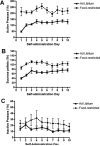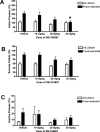Role of orexin/hypocretin in conditioned sucrose-seeking in female rats
- PMID: 25036612
- PMCID: PMC4188723
- DOI: 10.1016/j.neuropharm.2014.07.007
Role of orexin/hypocretin in conditioned sucrose-seeking in female rats
Abstract
The orexin/hypocretin system has recently been implicated in reward-seeking, especially for highly salient food and drug rewards. Given that eating disorders affect women more than men, we reasoned that the orexin system may be strongly engaged in female rats, and during periods of food restriction as we recently reported in male rats. Therefore, the present study examined the involvement of the orexin system in operant responding for sucrose, and in cue-induced reinstatement of extinguished sucrose-seeking, in ad libitum fed vs. food-restricted female subjects. Female Sprague Dawley rats were trained to self-administer sucrose pellets, and we determined the effects of pretreatment with the OxR1 receptor antagonist SB 334867 (SB; 10-30 mg/kg) on fixed ratio (FR) sucrose self-administration, and on cue-induced reinstatement of extinguished sucrose-seeking. SB decreased sucrose self-administration in food-restricted but not in ad libitum-fed females. SB did not alter active lever responding during cue-induced reinstatement of sucrose-seeking in either feeding group. These results confirm our previous results in male rats that signaling at the OxR1 receptor is involved in the sucrose reinforcement and self-administration in food-restricted subjects. However, the finding that SB is ineffective at attenuating cue-induced reinstatement in females, but was effective in food-restricted males, leads us to conclude that food seeking induced by conditioned stimuli engages the orexin system differentially in males and females.
Keywords: Conditioned stimuli; Females; Obesity; Orexin; Palatable food; Reward-based feeding.
Copyright © 2014 Elsevier Ltd. All rights reserved.
Figures




Similar articles
-
Role of orexin/hypocretin in conditioned sucrose-seeking in rats.Psychopharmacology (Berl). 2013 Mar;226(1):155-65. doi: 10.1007/s00213-012-2902-y. Epub 2012 Oct 25. Psychopharmacology (Berl). 2013. PMID: 23096770 Free PMC article.
-
Attenuation of saccharin-seeking in rats by orexin/hypocretin receptor 1 antagonist.Psychopharmacology (Berl). 2013 Aug;228(3):499-507. doi: 10.1007/s00213-013-3051-7. Epub 2013 Mar 15. Psychopharmacology (Berl). 2013. PMID: 23494235 Free PMC article.
-
Orexin/hypocretin signaling at the orexin 1 receptor regulates cue-elicited cocaine-seeking.Eur J Neurosci. 2009 Aug;30(3):493-503. doi: 10.1111/j.1460-9568.2009.06844.x. Epub 2009 Jul 28. Eur J Neurosci. 2009. PMID: 19656173 Free PMC article.
-
Role of orexin/hypocretin in reward-seeking and addiction: implications for obesity.Physiol Behav. 2010 Jul 14;100(5):419-28. doi: 10.1016/j.physbeh.2010.03.009. Epub 2010 Mar 23. Physiol Behav. 2010. PMID: 20338186 Free PMC article. Review.
-
Orexin-mediated motivated arousal and reward seeking.Peptides. 2024 Oct;180:171280. doi: 10.1016/j.peptides.2024.171280. Epub 2024 Aug 17. Peptides. 2024. PMID: 39159833 Review.
Cited by
-
Organization of connections between the amygdala, medial prefrontal cortex, and lateral hypothalamus: a single and double retrograde tracing study in rats.Brain Struct Funct. 2016 Jul;221(6):2937-62. doi: 10.1007/s00429-015-1081-0. Epub 2015 Jul 14. Brain Struct Funct. 2016. PMID: 26169110 Free PMC article.
-
Activation of lateral hypothalamic group III metabotropic glutamate receptors suppresses cocaine-seeking following abstinence and normalizes drug-associated increases in excitatory drive to orexin/hypocretin cells.Neuropharmacology. 2019 Aug;154:22-33. doi: 10.1016/j.neuropharm.2018.09.033. Epub 2018 Sep 22. Neuropharmacology. 2019. PMID: 30253175 Free PMC article.
-
Can We Selectively Reduce Appetite for Energy-Dense Foods? An Overview of Pharmacological Strategies for Modification of Food Preference Behavior.Curr Neuropharmacol. 2016;14(2):118-42. doi: 10.2174/1570159x14666151109103147. Curr Neuropharmacol. 2016. PMID: 26549651 Free PMC article. Review.
-
The contribution of orexins to sex differences in the stress response.Brain Res. 2020 Mar 15;1731:145893. doi: 10.1016/j.brainres.2018.07.026. Epub 2018 Aug 3. Brain Res. 2020. PMID: 30081036 Free PMC article. Review.
-
Environmental Enrichment During Adulthood Reduces Sucrose Binge-Like Intake in a High Drinking in the Dark Phenotype (HD) in C57BL/6J Mice.Front Behav Neurosci. 2019 Feb 15;13:27. doi: 10.3389/fnbeh.2019.00027. eCollection 2019. Front Behav Neurosci. 2019. PMID: 30828291 Free PMC article.
References
-
- American Psychiatric Association . Diagnostic and Statistical Manual of Mental Disorders. 4. Washington, DC: 1994.
-
- Blundell JE. Dose-response effects of orexin-A on food intake and the behavioural satiety sequence in rats. Regul Pept. 2000;96:71–84. - PubMed
Publication types
MeSH terms
Substances
Grants and funding
LinkOut - more resources
Full Text Sources
Other Literature Sources

